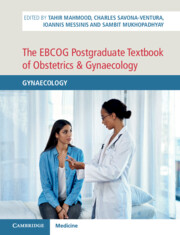Book contents
- The EBCOG Postgraduate Textbook of Obstetrics & Gynaecology
- The EBCOG Postgraduate Textbook of Obstetrics & Gynaecology
- Copyright page
- Dedication
- Contents
- Videos
- Contributors
- Preface
- Section 1 Basic Sciences in Gynaecology
- Section 2 Menstrual Disorders
- Section 3 Reproductive Endocrinology and Infertility
- Section 4 Contraception and STIs
- Section 5 Post-Reproductive Care
- Section 6 Vulva and Vagina
- Section 7 Cervix
- Chapter 33 Pre-invasive Cervical Disease and Colposcopy
- Chapter 34 Clinical Management of Cervix Cancer
- Section 8 Uterus
- Section 9 Ovary and Fallopian Tubes
- Section 10 Operative Gynaecology
- Section 11 Public Health Issues in Gynaecology
- Section 12 Miscellaneous
- Index
- Plate Section (PDF Only)
- References
Chapter 33 - Pre-invasive Cervical Disease and Colposcopy
from Section 7 - Cervix
Published online by Cambridge University Press: 24 November 2021
- The EBCOG Postgraduate Textbook of Obstetrics & Gynaecology
- The EBCOG Postgraduate Textbook of Obstetrics & Gynaecology
- Copyright page
- Dedication
- Contents
- Videos
- Contributors
- Preface
- Section 1 Basic Sciences in Gynaecology
- Section 2 Menstrual Disorders
- Section 3 Reproductive Endocrinology and Infertility
- Section 4 Contraception and STIs
- Section 5 Post-Reproductive Care
- Section 6 Vulva and Vagina
- Section 7 Cervix
- Chapter 33 Pre-invasive Cervical Disease and Colposcopy
- Chapter 34 Clinical Management of Cervix Cancer
- Section 8 Uterus
- Section 9 Ovary and Fallopian Tubes
- Section 10 Operative Gynaecology
- Section 11 Public Health Issues in Gynaecology
- Section 12 Miscellaneous
- Index
- Plate Section (PDF Only)
- References
Summary
Cervical cancer remains the major cause of death from cancer in women worldwide. While well-established screening programmes and treatment of pre-invasive disease are available in economically developed countries, screening remains opportunistic to non -existent in low-income countries. Cervical cancer and its precursors are caused by persistent infections with high-risk HPV. Early-onset sexual intercourse is an important factor for HPV infection. Excisional treatment for pre-invasive disease is preferred to ablative treatment. A simple hysterectomy is adequate for most microinvasive cancers of the cervix. Virus like particles (VLPs) assembled from recombinant HPV coat proteins are used to constitute HPV vaccine. It has the advantage of being non-infectious, as they contain no viral genetic material. The vaccines prevent HPV-related cancers and ideally are given before sexual debut. Guidelines vary between countries, but vaccination is usually initiated between 9–12 years for both sexes. Preventive HPV vaccination for both sexes remains a cornerstone of preventing HPV related cancers globally.
Keywords
- Type
- Chapter
- Information
- The EBCOG Postgraduate Textbook of Obstetrics & GynaecologyGynaecology, pp. 275 - 283Publisher: Cambridge University PressPrint publication year: 2021

